Menu
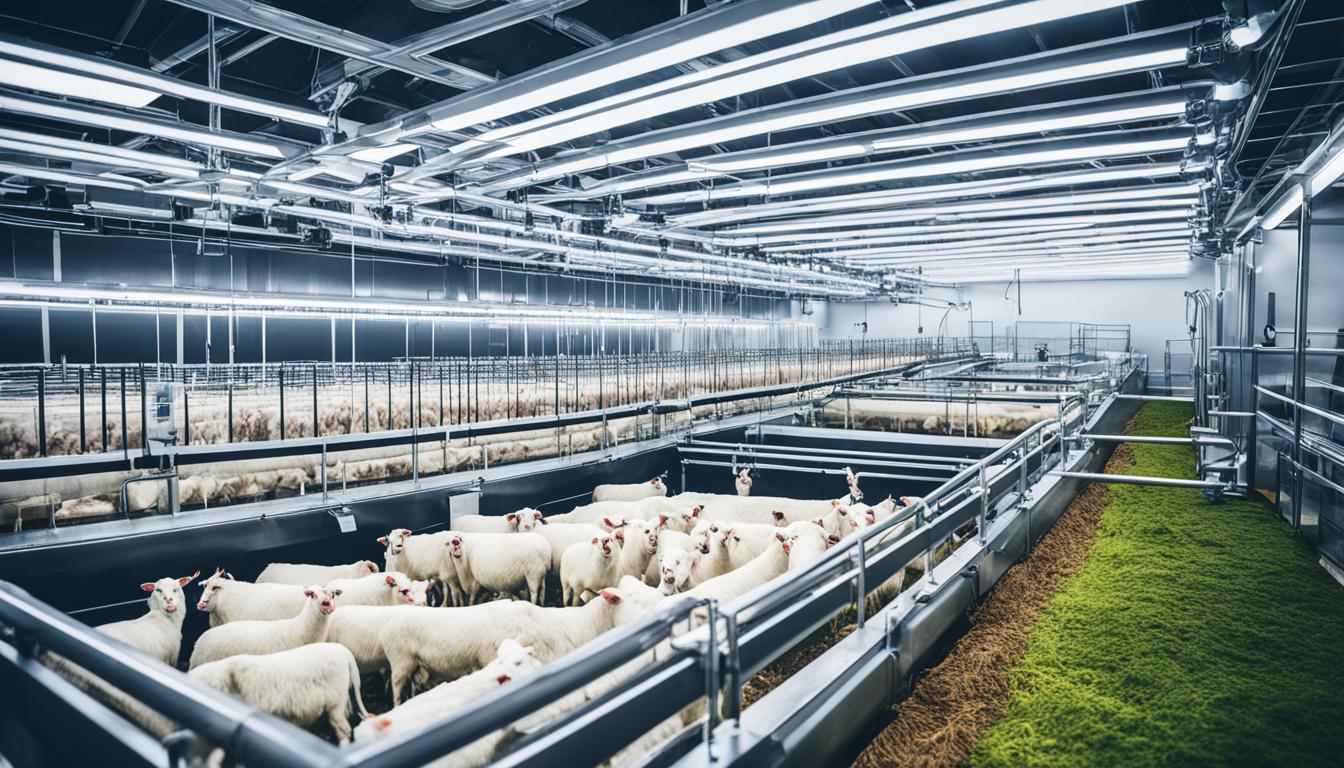
Community-based breeding programmes (CBBPs) are making a big difference. They help by improving the market for animals and their products. This drives farming forward, making better genetics and sustainable farming more possible.
The importance of smart breeding plans is clear for cows, pigs, and chickens. A study by Animal (2016) shows that how we raise animals is key. We must meet the growing demand while caring for the environment and the animals.
CBBPs especially help farmers with less land. They focus on local genetic resources and using everyone’s ideas. This way, they keep farming strong, even as times change.
Livestock breeding programmes are key to modern agriculture’s success. They use various breeding techniques to improve animal productivity and welfare. With global demand for animal products set to double, these programmes are more critical than ever to support our growing needs.
The size of the effective population (Ne) is vital for success in breeding programmes. It influences how well animals evolve, adapt, and respond to selection. Inbreeding depression, caused by low genetic variation, can harm a population’s ability to adapt and reproduce effectively.
Domestic animals face challenges just like those in the wild when Ne is small. They may have reduced traits for performance and suffer more from inbreeding. These issues can lead to the decline of their populations.
Despite these challenges, selective breeding in livestock can still improve production traits. But, there’s always a risk of extinction, especially due to unpredictable environmental and demographic factors. Therefore, managing Ne is vital for keeping livestock populations viable.
Here’s a detailed look at effective population size and its significance:
| Aspect | Impact |
|---|---|
| Small Ne in Natural Populations | Reduced genetic variation and increased inbreeding depression. |
| Small Ne in Domestic Populations | Decreased performance traits and higher risk of extinction. |
| Intensive Directional Artificial Selection | Genetic gains for production traits despite low genetic diversity. |
In breeding programmes, managing Ne well is crucial to avoid inbreeding depression. This is particularly important for activities that affect an animal’s health and ability to survive. Such challenges are significant even in domestic species.
Modern breeding programmes also focus on improving animal welfare and reducing environmental harm. This includes lowering emissions that contribute to climate change and affect air quality. Such initiatives make animals healthier and the industry more sustainable.
Pigs and poultry, for example, now need half the amount of feed they did 40 years ago, thanks to these breeding advances. It’s essential to keep improving these programmes to fit the needs of farms. Part of this work involves supporting local breeds to maintain biodiversity.
Good breeding strategies are a big deal for not only making sure we have enough food but also for making animals better over time. We use different methods, like using the latest in genetics and working with local groups on breeding, to keep animals healthy and productive.
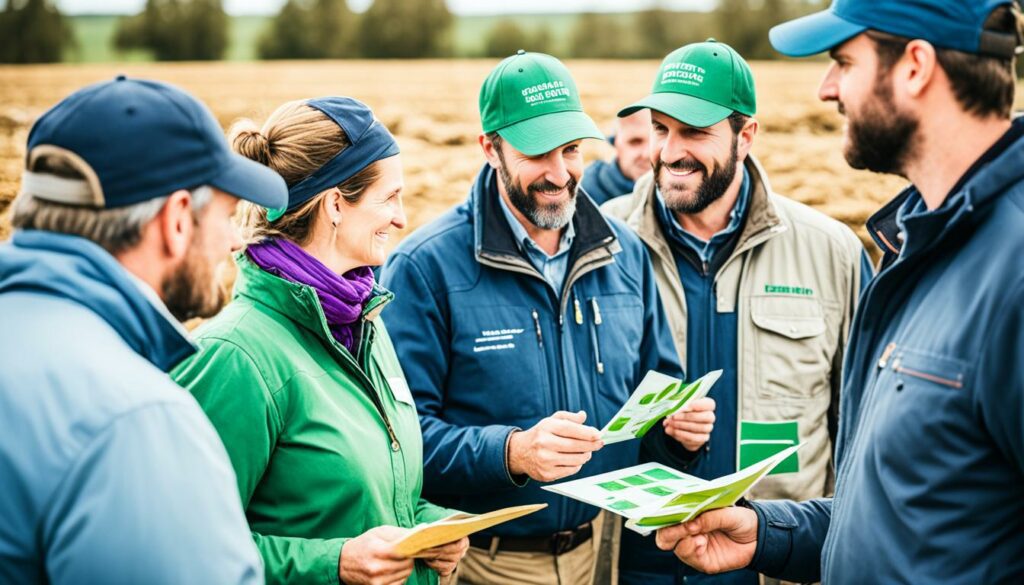
Some ways of breeding, like bringing in genes from other groups, are really good at making animals do well and adapt to change. Research shows that by choosing the best genes with modern methods, we can make animals better for things they didn’t do so well before.
This process picks the best bits from one group of animals to give to another. It makes the animals stronger in ways we want them to be. For example, they might produce more milk or resist diseases better.
Using computer models, we’ve found that breeding with a certain number of males and females works better than old ways. It shows we need strong ways of doing things with genes. These ways help farms in different places, especially where the weather can change a lot.
Making a lot of food and keeping animals healthy is tough. When it’s hot, cows can make less milk and find it harder to have babies. But by picking the best animals through their genes, we can do better than before without making sacrifices.
It’s also important to use local animal types in our breeding efforts. These animals are already used to where they live and can handle diseases better. Mixing them with new types might seem good, but it can make them weaker. So, we need to think about how choosing the right animals to breed helps not just our farms, but also our culture and the environment.
Community-based breeding programmes (CBBPs) help smallholder farmers improve their lives. They let farmers take part in breeding to meet goals and save local genes. Let’s see how these programmes help.
Small farmers are critical in CBBPs. They decide on and reach goals for breeding, like faster growth and better health for the animals. This boosts farm output and earnings. By choosing what’s bred, farmers make sure it meets their needs, making the programmes more helpful.
In many places, CBBPs have had great results. In Ethiopia, more than 130 areas joined the programme for sheep and goats. They saw real improvements in their animal’s genes. Malawi and Tanzania also found that their goats grew better and had more meat because of CBBPs. Here are some more success stories:
| Region/Country | Species | Key Achievements | Year Initiated |
|---|---|---|---|
| Ethiopia | Sheep and Goats | Involvement of over 130 communities, quantifiable genetic gains | 2009 |
| Malawi and Tanzania | Local Goats | Substantial gains in growth and carcass yields | 2015 |
| Burkina Faso, Iran, Liberia, South Africa, Sudan, Uganda | Sheep and Goats | Implementation for genetic improvement and economic impact | Varied (2009-2017) |
These cases show how CBBPs can work in different areas with different animals. They have made a big difference. With help from governments and others, these projects can grow and do even more good.
Animal husbandry is always changing, especially with new breeding methods. These new ways, like using advanced genetics, have changed livestock breeding programs. Now, with better DNA tech, we can pick the best genes for breeding. This is thanks to recent huge steps in DNA sequencing, allowing us to check millions of animals.
TALENs and CRISPR/Cas9, gene tools, are changing how we make farm animals. For example, we’ve made double-muscled pigs by changing a key muscle gene. This shows how powerful gene editing can be in improving traits in farm animals.
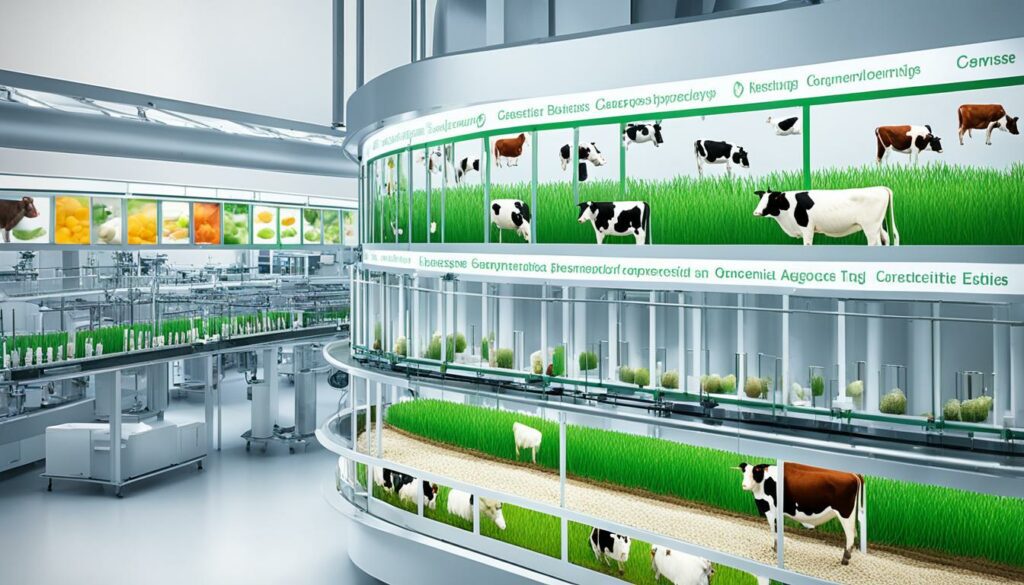
Research on dairy cattle has shown us why using genomics in breeding is so important. It helps to avoid bad gene matches that can affect how fertile the cows are. This teaches us that we must look deep into genes to make the best choices in breeding.
Moving from simply changing genes to precisely editing them is a big leap for animal husbandry. This change isn’t just about mixing in new genes. It’s about improving how we breed animals. Using smart breeding plans is key to getting the best genetic progress over time. This shows us how important smart, data-led strategies are in today’s livestock breeding programs.
Selective breeding is key in farming, making animals better suit our needs. It boosts the traits we want in livestock, from better milk to more eggs. This helps keep farms sustainable and meet what consumers, like us, want.
Thanks to selective breeding, the amount of corn grown in the USA soared by 275% from 1900 to 2001. Farmers found ways to make corn plants more efficient, leading to bigger harvests.
By using different breeding methods, like outcrossing and inbreeding, farmers can pick several traits to improve at once. For example, dairy cows are bred to make more milk that’s rich in protein. This not only helps the farmers but also makes the cows healthier.
“Effective selective breeding technology has achieved dramatic improvements in livestock productivity over the last fifty years,” – UN FAO Report.
There are some downsides to selective breeding. It can rely on things like fossil fuels, which is not great for the planet. But, governments can help by promoting sustainable farming. They offer support to choose stronger, more natural animal breeds.
Taking in lessons from local people can also make breeding more planet-friendly. This includes using old, wise methods to protect nature and make animals stronger. Using both technology and old ways can create win-win solutions for farming and the environment.
| Metric | 1900 | 2001 |
|---|---|---|
| Yield of Corn (t/ha) | 2.5 | 9.4 |
| No. of Eggs Laid by Hens | 30 | 300+ |
Choosing animals carefully and keeping their genes diverse are critical. This ensures our efforts in breeding are successful. As we get better at selective breeding, we can make more improvements. This helps farming stay strong and benefits everyone.
Well-structured livestock breeding programmes bring big economic gains. In Europe, these programmes add about €2 billion yearly to the agricultural sector. They help meet the growing global demand for animal products. This shows their high value and importance.
The numbers tell a clear story. Humankind’s organised efforts in poultry and swine have paid off massively. Since 1940, growth rates have jumped by 350% and 250%, respectively. Likewise, in aquaculture, tilapia, salmon, and shrimp have seen progress. Their growth rates have soared by 350%, 270%, and 240%, bringing with it great economic hope.
A notable example is selective breeding in tilapia. They achieved a 10% daily weight gain increase and improved feed use and survival rates. Overall costs dropped by 10%, including lower fingerling and feed costs. This breeding also increased profits by 6.1% and brought over $2,000 in gains per 10,000 tilapia raised. It shows the clear economic wins of such programs.
| Breeding Program | Economic Benefits |
|---|---|
| Organised Poultry Breeding | 350% growth rate increase since 1940 |
| Organised Swine Breeding | 250% growth rate increase since 1940 |
| Selective Tilapia Breeding | 350% growth rate increase since 1985 |
| Selective Salmon Breeding | 270% growth rate increase since 1975 |
| Selective Shrimp Breeding | 240% growth rate increase since 1990 |
Less than 15% of aquaculture comes from selective breeding. This leaves great potential for growth. While land animal breeding is ahead, aquaculture can quickly catch up. A 10% growth per generation is achievable. This points to the big impacts these programmes can have.
The aquaculture sector shows how advanced breeding can be highly adaptable and efficient. For instance, improving genetics in ruminants can reduce emissions by up to 26% in some places. In the USA, dairy production has cut methane emissions by 40% through breeding advancements. These changes not only save money but also help the environment, making a strong case for investing in breeding programmes.
It’s crucial to consider animal welfare when breeding animals. This ensures they stay healthy and live longer. Following rules and policies helps keep care standards high.
The Hawaii Endangered Bird Conservation Program is a great example. Run by San Diego Zoo Global since 1993, it has helped 16 bird species. The Opportunities to Thrive programme is key here. It aims to improve welfare by reducing stress and health problems, and by increasing the birds’ ability to reproduce.
The right food is very important for bird welfare. A proper diet impacts how well chicks do and how healthy the birds are. San Diego Zoo Global closely watches birds’ health with body condition scores. Low scores can mean less breeding success and slower recovery from illness. By keeping an eye on both the birds’ conditions and diets, they follow welfare rules and aid in better breeding.
Following breeding rules is important to meet ethical and animal welfare laws. For instance, the Hawaii Endangered Bird Conservation Program follows strict guidelines. Policies here help ensure animals are not just avoiding harm, but also showing good welfare signs like self-grooming and bathing. This makes their living environments better.
| Program | Species Cared For | Key Focus |
|---|---|---|
| Hawaii Endangered Bird Conservation Program | 16 endemic Hawaiian species | Release over 800 birds into the wild |
| Opportunities to Thrive | Various species at San Diego Zoo Global | Guidance on managing animal welfare and breeding |
To sum up, putting animal welfare first in breeding is key. Doing this alongside strict rules helps protect and improve the lives of many species. It’s all about ensuring a good future for them.
Breeding programmes are key in saving the planet’s variety of species. They help preserve various genes, making sure living things can survive in new conditions. This is vital for keeping our world diverse and healthy.
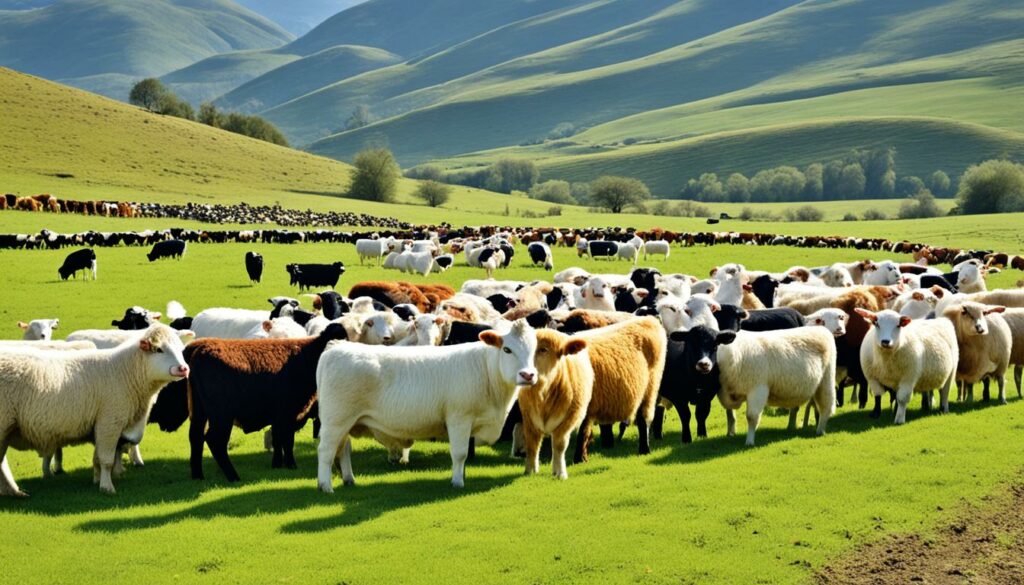
Programmes that breed animals in captivity save species from dying out. They keep a wide range of genes in these species alive for the future. But, sometimes, animals bred in captivity may not be as strong as those in the wild. This happens when they’ve been kept for a long time in captivity.
The success in keeping a variety of genes and health in these animals varies by programme. But, overall, breeding in captivity has proved crucial in protecting many species from extinction.
Factors contributing to salmonid declines include overexploitation, habitat loss, environmental changes, negative interactions with wild counterparts, and invasive species.
By combining breeding in controlled settings with natural births, programmes aim to save natural species from the brink. They work to protect diverse genes and overall health of species key to our planet. Every year, in Europe, about €2 billion comes from these activities, showing they’re both economically and ecologically valuable.
Captive breeding programs not just save single species. They also help keep entire ecosystems strong. Yet, there’s still a lot to learn about if these bred animals can survive on their own. So, we need to keep studying and carefully using these programmes.
Setting up good breeding programmes faces lots of hurdles. The world changes fast, and there’s pressure on farming from all sides. Leading the way are Community-based Breeding Programs (CBBPs) in places like Ethiopia, Malawi, and Tanzania. They involve the local people and use science to make progress. Through these efforts, over 130 communities in Ethiopia have seen real progress.
Big challenges for breeding projects include having the right tools and people. In many warm areas, old tools and buildings hold back local livestock. Also, there are not enough experts to help. So, these projects are not as good as they could be. To overcome this, we need to teach and train more people so they can run these programmes well.
Working together helps a lot in facing these challenges. Take CBBPs, for example. They get farmers together to look after sheep and goats. Soon, these groups become strong cooperatives. They get better by choosing the best male animals for breeding, with help from local scientists. This smart way to choose breeders is all based on facts, making sure we get better livestock.
In some cases, companies that work on poultry and pig breeding show us a good way forward. They have clear plans to make genetics better. But, they need to remember to work on the living conditions of the animals too. This way, the animals can keep on performing well in changing conditions.
Keeping our livestock genetics diverse is crucial. Yet, we often see less variety today, with local breeds being replaced by global ones. Saving this diversity is key for the future of farming. By smartly choosing which animals to breed, we can actually get even better results while keeping our animal families healthy.
In conclusion, solving breeding challenges needs a combined effort. We must improve how we keep animals, train more people, work together, and preserve genetic variety. Doing so ensures our breeding efforts lead to long-lasting success.
The way we breed livestock is changing fast thanks to technology. This change doesn’t just improve farming methods. It also makes sure the animals are the best they can be, both in quality and how well they produce.
Artificial insemination is changing how we breed animals, making it more precise. It allows breeders to pick out the best traits, like more milk or being healthier. Then, with genetic testing, we can tell exactly which genes make these good traits happen.
This detailed test helps create herds of animals with the best genetics. This means they are more productive and healthier. It helps make sure the next generation of animals is even better than the last.
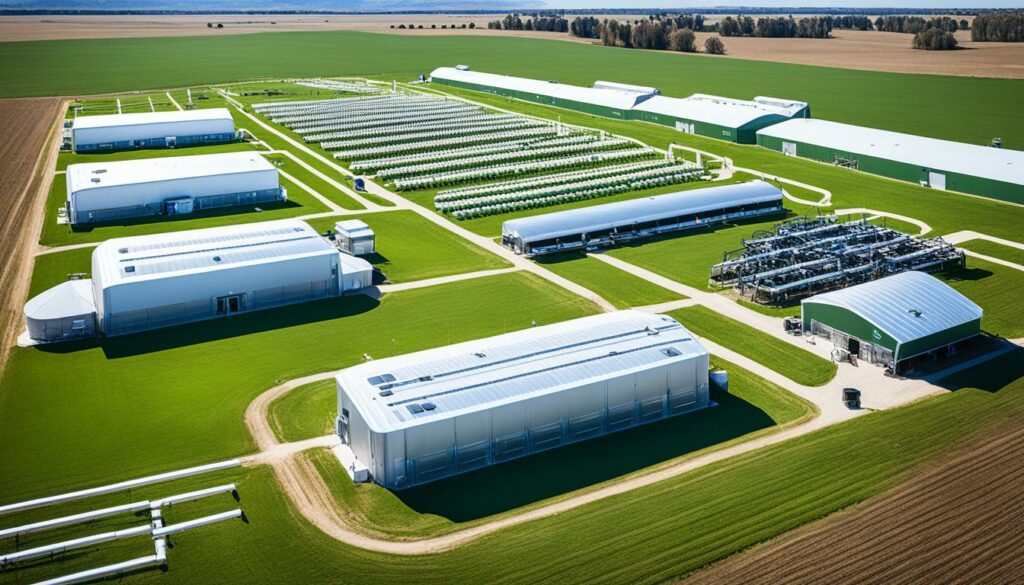
Data and analytics are changing how we breed animals by making choices smarter. This is done by looking at lots of data to guess what might happen next. An example is cows with special sensors that send data about their health and how much they produce. This makes taking care of animals easier and more effective.
Companies like Cainthus and Rex Animal Health are leading the way in using new tech to solve problems in farming.
| Research Articles | Review Articles | Systematic Review Articles | Method Article |
|---|---|---|---|
| 25 | 5 | 3 | 1 |
Using data and analytics for feeding animals is also working well. Things like probiotics and enzymes in their food are making them healthier and work better. This shows how important it is to use technology in farming, to make it both sustainable and profitable.
Livestock breeding is changing fast. Advanced genetic editing is key. It helps make animals better for farming. This is a big deal in how we raise livestock (Gonen et al., 2017).
Breakthroughs in genome editing have made genome-edited sheep, cattle, and pigs. This shows we can do amazing things in breeding.
Today, we’re using better techniques to breed livestock. Advanced breeding technologies are becoming the norm. They lead to healthier and more efficient farming (Thornton, 2010).
Such methods are great at tackling genetic diseases in cattle. They can even create genetically unique pigs from one pregnancy (Li et al., 2015).
The key is to keep studying the genes of many animals. This helps us breed smarter. Sustainable farming is the goal. It’s about being good for the planet and making profit too (Hickey, 2013).
| Year | Research Focus | Findings |
|---|---|---|
| 2012 | Poultry Genetics | Advancements in genetic selection documented |
| 2023 | OECD/FAO Agricultural Outlook | Trends and forecasts for livestock breeding |
| 2020 | Chicken Genome Ancestry | Insights into genetic evolution of chickens |
| 2021 | Global Chicken Population Study | Connections between populations and breeding events |
| 2010 | Turkey Domestication | Complexity of indigenous North American turkeys |
| 2013 | Pig and Poultry Breeding | Role in ensuring food security highlighted |
The future of livestock breeding is bright. By blending new tech with smart research, we’re heading towards a greener, more efficient farming. This new approach puts better genes and caring for the earth first.
Choosing the right breeding stock is key to making livestock more productive. Good breeding schemes pick animals that are productive, healthy, and easy to handle. Using methods like artificial insemination and embryo transfer can help bring in new genes. This makes breeding more successful overall.
Today, technology is at the heart of breeding. We can use ultrasound to check if animals are pregnant. Tools like Cattlytics make it easier to keep careful records of each animal’s progress. This helps us make sure every animal gets the right diet, which keeps them healthy. We also work hard to prevent diseases through steps like vaccinations and quarantines.
Interbreeding different animals can bring out the best in them. Genetic tests help us pick the best animals for breeding. It’s important to keep an eye on when female animals are ready to mate. This makes sure our animals are strong and stay productive.
Breeding programmes that involve nearby communities can really thrive. Such programmes have worked well in places like Ethiopia, Malawi, and Tanzania. They start by selecting improved local breeds to avoid genes getting too similar. Then, local farmers work with experts to manage the process and collect data. These efforts have helped many areas improve their livestock, making a big difference to how people live.
To make a success of breeding programmes, it’s important to set clear goals that match what the market needs. Getting local people involved in choosing which animals to breed helps ensure success and fairness. Linked to this is organized support, training, and opportunities to sell animals. This support really helps make breeding programmes strong and able to grow. By learning from what works and sharing these stories, we can encourage more progress in breeding programmes worldwide.
The main aims are to make animals better in every way. This means making their genes stronger, looking after them more, and making more animal products. These goals also look at keeping the environment healthy and the food we get safe.
They are key to making farming last long without using up everything. By using these programmes, we don’t just get better animal products. We also get farming that stays healthy, diverse, and makes good money.
They cover everything to help farming stay around for ages. By caring about animals’ health and the way they live, farms can keep going. These green strategies also mean farms can make money in smart ways.
They are the stars in these programmes. These farmers don’t just join in. They help set the goals and make sure the special animals they have are used. This work helps keep the programme alive and makes money for everyone involved.
They are using amazing new ways to make animals better. Things like putting sperm in artificially, checking DNA, and using clever maths make a big difference. This means the animals can work and live better.
It’s about picking the best animals to have babies. By choosing carefully, we make sure the good things about these animals are passed on. This can mean they work harder, get sick less, and fit their homes better.
They help farms and their countries earn a lot. In Europe alone, breeding makes about €2 billion every year. This shows how important and valuable it is.
Looking after animals comes first in these programmes. They make sure the animals are well and follow the rules. This means the animals are happy and healthy in good homes.
They help keep the different kinds of animals safe. By doing this, they make sure we always have animals that are strong and fit for their surroundings. It keeps the animal world rich and interesting.
There are lots of problems like fast changes, big worldwide demands, and making sure what we do lasts. To fix these, we need smart plans, new ways to breed, and to be careful in what we do. This will overcome the challenges well.
New tech helps a lot in breeding. Things like artificial insemination and smart computer programs make breeding better. They give us stronger animals and help make good decisions.
Now and in the future, we want to farm in ways that don’t harm the earth. This means using the best tech and caring for animals well. The goal is to have farms that last and meet our needs in a good way.
The best ways include working together, using new techniques, and thinking about the future. Some stories show how much better animals have got, how goods farms are now, and how people in the area are doing well because of these programmes.